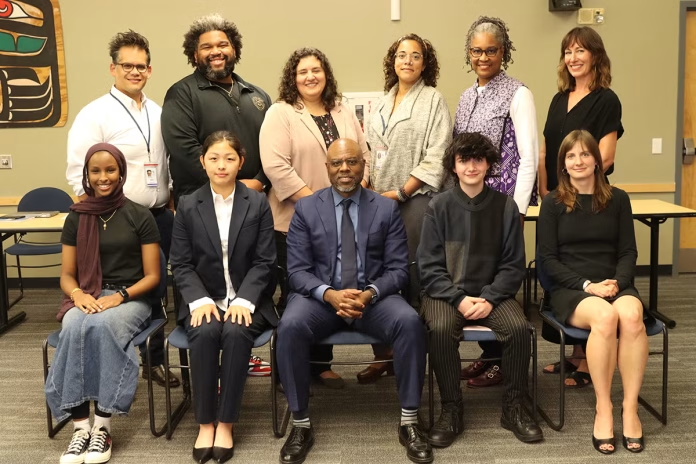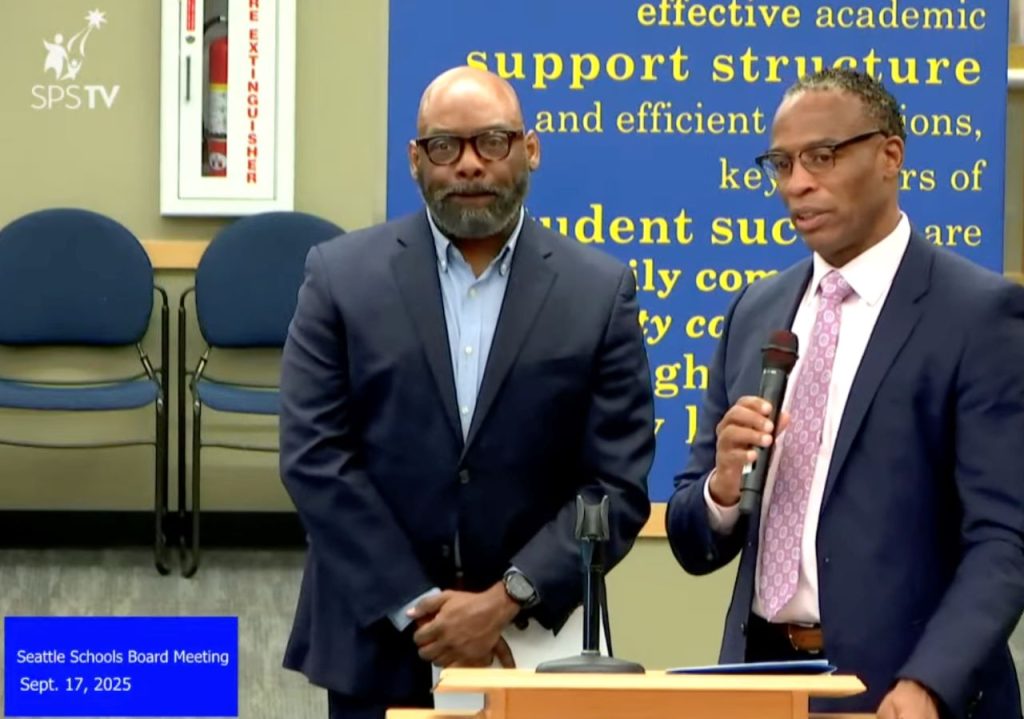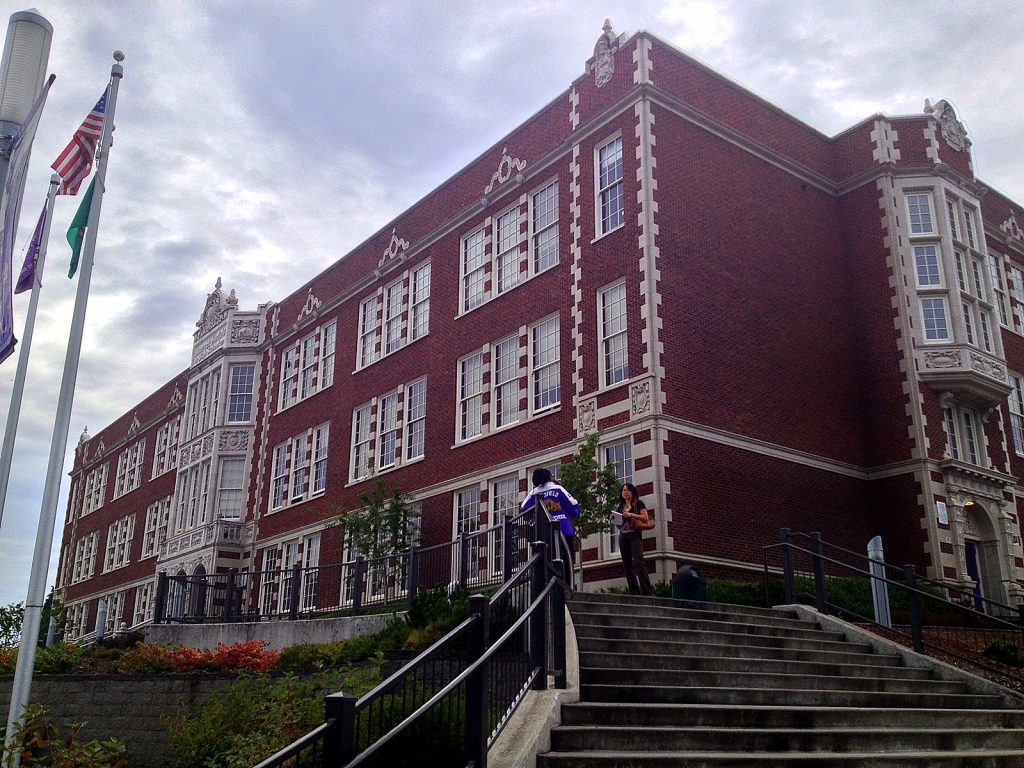
Seattle Public Schools. Say that phrase and you’ll get a plethora of opinions but as someone who has tracked public education in Seattle for 25+ years, the two thoughts you will most often hear are “I believe in public education” and “What the heck are they doing; the district is a mess.”
The district has been and continues to face major problems that have been exacerbated by upheavals in leadership, funding issues, and frankly, just not listening to parents.
The Seattle School Board saw two members leave in the middle of their terms in 2024. The new directors who replaced them came in with a huge learning curve ahead of them. The two are Sarah Clark and Joe Mizrahi; both have chosen to run and try to retain those seats in the November election. Overall, the majority of the Board is up – 4 out of 7 seats will be on the ballot.
Leadership – the Superintendent
In 2022, Superintendent Denise Juneau resigned and the Board appointed long-time senior leader, Brent Jones, as interim. The Board then decided that they did not want to do a search and then summarily installed Jones without any vetting from the public. Even so, Jones was a known quantity and certainly knew the district well.
Last year, Superintendent Jones and senior staff made an ill-advised move to submit a plan to the Board to close 20 schools, all of them either K-8s or Option Schools. That plan landed with a thud and was the tipping point for some on the Board who seemed to want to exit Jones. The complaint was that he and senior staff were not giving complete information that some on the Board asked for repeatedly and it reached a boiling point in spring 2024.

Jones first said he would finish his contract which ended in July 2025. Soon after, Jones said he had a medical issue and left the district. The Board then appointed Fred Podesta, Chief of Operations, as the interim superintendent and now acting superintendent, as they launched a superintendent search. Podesta is not interested in the superintendent job as a permanent position.
To note, the Board was NOT following the timeline for most national superintendent searches which generally go from September to December with a pick coming in the spring. Meaning, the Board came in near the end of the regular timeline which means they might be getting all the candidates rejected by other districts.
Where are we now? In September, the Board narrowed its search down to eight candidates via the search firm HYA (Hazard Young & Associates). In executive session, the board voted to narrow the field down to two in October and expected to announce the name of their finalist shortly.
So if you follow the bouncing ball, that means that SPS will have a new superintendent and, after the November elections, there could be up to four new people on the Board.
That’s a lot of churn at the top.
Funding Issues
In short, the district is spending more than it is taking in. The Alliance for Education paid for a group – Education Resource Strategies (ERS) – to come in and do a deep dive on what ERS called “Aligning Resources to Strategy and Need.” Here’s the best topline summary from the report:
- Imagine a family thought they’d need $10,000 from savings to cover their budget.
- But thanks to $3,600 in surprises (like winning a small lottery prize or canceling a vacation), they only needed $6,400.
- They still spent more than they earned, but not as much as expected and they still needed to spend $6,400 out of their savings to make ends meet.
The district’s Operating budget is $1.23 billion dollars.
The State funds around 63%, local taxes (meaning, levies) fund 15.9%, federal dollars are around 6.5% (which is largely to support Title One schools which serve low-income students as well as dollars for Special Education and homeless students), other revenue is 6.1% (mostly from school/facilities rentals or gifts and donations), 4.9% other resources and fund balance 4.2%.
Students drive state funding. For a long time, the enrollment in Seattle Public Schools (SPS) was about 50,000. But SPS has been steadily losing students over the last five years. The pandemic may be part of that as well as housing costs but it also appears that Seattle parents are voting with their feet. The district has lost about 1,500 students over that time period. October 1 is the official state head count date and it appears that SPS will have lost another 300 students and will now drop down to just under 49,000 students.
About 73% of the spending is on teaching and learning which includes teachers, nurses, librarians, counselors, textbooks, and student supplies. To note, the State only funds about four nurses for 49,000 students. Clearly, that is not enough so SPS has to fund additional nurses. This is an example of where the district is not getting enough funding from the State.
Where is there problematic spending in SPS? The ERS report showed that SPS spends much more in Special Education costs and transportation than peer districts.
On Special Education, in 2022-23, SPS spent $92.5 million. In 2023-24, it was $108.5 million and this school year, it is projected to spend nearly $121 million.
Of course, children with disabilities need supports. No one is arguing against that. However, there is one school board candidate, Janis White, who is an expert in Special Education and she questions the number of students that the district sends out of district for services. Each of these student services can cost upwards of $500,000 to $1 million. Some of these students are ones who need a residential facility to meet their needs but White wonders if the district has tried hard enough to find local services for many others.
On the transportation side, the district spent about $68 million in 2022-2023, $50 million in 2023-2024 and this year it is projected to be nearly $60 million. The district is using two vendors in trying to cut those costs. One oddity not seen in other districts, is the level of use of private cars (taxi/Uber/Lyft) to transport homeless and other students.
In an effort to close the widening budget gap, the district did two major things. One, they drained the “Rainy Day” fund. That’s the emergency fund the district uses if it faces an unexpected financial hardship, like if a building burns down. Two, they borrowed money from the Capital fund. Normally districts cannot use Capital funds for General Education spending. However, there is a clause in state law that allows districts to do this for a couple of years, but the money must be paid back with interest.
The district has not replenished either fund and it’s unclear how they will do that. So the budget woes continue.
Safety
There have been two fatal shootings at two different Seattle high schools in the last three years. In the case of the 2022 Ingraham High School shooting that occurred in the school, a 15-year old boy pleaded guilty.
The 2024 shooting at Garfield High School, where a student was killed trying to break up a fight just outside the building, still has not been solved. There have been multiple drive-by shooting attempts at Garfield, as well.

SPS has created a list of safety actions they propose and the City has shown willingness to help. But the biggest idea is bringing back a Seattle Police officer to the high schools with a pilot program starting at Garfield.
Former Garfield High principal Ted Howard rightly points out that none of the current student body has ever had a police officer at school and that the MOU between the district and SPD will have strict parameters.
If you listen to students – and 1,000 walked out of their schools just weeks ago over safety issues – they want to feel safe. And yet the Board punted, yet again, on this issue of SPD in SPS at the last Board meeting.
Student Outcome Focused Governance
SOFG – No, not a new detergent but a governance system that is being enacted in SPS. SOFG stands for Student Outcome Focused Governance. Sounds good, right? But in this case, the devil IS very much in the details.
More than a decade ago, the Seattle School Board was often called out for “micromanaging” the superintendent. Micromanaging would be an exaggeration of what their job really is, which is oversight of the district on behalf of the public.
Several years ago, a local consulting firm was hired by the Board. One of the firm’s recommendations was to find and use a new governance system but how SOFG came to SPS is something of a mystery. Mind you, the Board gave no public notice about changing governance. They did not say anything until they had picked SOFG.
Basically, SOFG says that boards should ONLY work in the policy area, leaving all the operational decisions to the superintendent. How has that played out?
- The Board changed their notification policy so that the superintendent only has to report spending over $1 million to them (versus the previous $250,000) and that doesn’t have to be an immediate notification, just a quarterly one.
- The Board went from two legislative meetings a month to one. Nearly every Board committee has been dissolved including Operations, a key committee.
- The Board has done two things with the Board meeting agenda. Nearly every item now is Intro/Action, meaning they introduce the item AND vote on it at a single meeting.
- The other thing they did was to move most items to the Consent Agenda. With that move, the Board now votes on multiple items with just a single vote. So now, most items have zero Board discussion.
- The Board is supposed to stop in the meeting of their sole monthly meeting and do “self-reflection” on how they are following SOFG. It is a jarring thing to watch especially for the members of the public who have to sit there twiddling their thumbs as the directors basically navel gaze.
- At first, it appeared to be a system for the Board to work under. Then, the Board wants the superintendent and senior staff to use it and it appeared that senior staff balked at that idea. There is yet another report from the same consultant firm saying all the things that need to be done for SOFG to be fully implemented and that includes hiring more Central Office staff.
- Under SOFG, directors can’t even go to a school without an appointment.
So what would be the reason we vote for school directors if they are not providing oversight and listening to parents? That is unclear.
To note, SOFG is not cheap. There is coaching, conferences, membership costs, etc.
Bureaucratic culture
When the district suffered a financial scandal back in 2003, a local consulting firm, Moss Adams, did a complete sweep of every department at headquarters. The resulting report was amazing, complete with high/medium/low in terms of urgency and high/medium/low costs to fix for each issue raised.
But Moss Adams ended the report by noting that a building of people working siloed from each other in their respective areas is unlikely to produce good results. They said:
“If you do not change the culture of a bureaucracy, you change nothing.”
My hope is that a new superintendent will recognize the major shifts that need to happen for Seattle Public Schools to be a successful district and a new Board will help enact that.
So, what can I tell you that is good about SPS?
- First, the Board elected itself one of the best Board presidents ever in Director Gina Topp. Calm, firm, unflappable. She knows how to run a meeting. Will she be able to get the entire Board to vote in unison for a new superintendent?
- Great schools. Don’t listen to naysayers – SPS has great neighborhood schools, Option Schools, and dual-language schools. SPS has expanded CTE (Career, Technical Education, formerly vocational education) in all directions to have offerings more students want.
- To the district’s credit, they have not lost a levy since the late ‘90s which is a huge vote from Seattle which, after San Francisco, has the smallest child population for a major city in the country. This ability to pass levies easily is not seen in other major districts in the country.
- Beyond that, PTAs are among the largest grant supporters in SPS. Parents really step up to help including, in some areas, forming groups to support schools with low PTA numbers.
Melissa Westbrook is the writer/moderator for the Seattle Schools Community Forum blog. She has been a public education advocate for more than 25 years.

